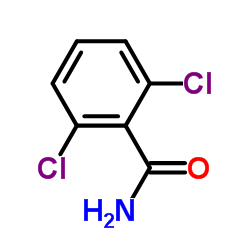2,6-二氯苯甲酰胺

2,6-二氯苯甲酰胺结构式

|
常用名 | 2,6-二氯苯甲酰胺 | 英文名 | BAM |
|---|---|---|---|---|
| CAS号 | 2008-58-4 | 分子量 | 190.027 | |
| 密度 | 1.5±0.1 g/cm3 | 沸点 | 300.7±52.0 °C at 760 mmHg | |
| 分子式 | C7H5Cl2NO | 熔点 | 196-199 °C(lit.) | |
| MSDS | 中文版 美版 | 闪点 | 135.6±30.7 °C |
|
Study of degradation intermediates formed during electrochemical oxidation of pesticide residue 2,6-dichlorobenzamide (BAM) at boron doped diamond (BDD) and platinum-iridium anodes.
Chemosphere 109 , 84-91, (2014) Electrochemical oxidation is a promising technique for degradation of otherwise recalcitrant organic micropollutants in waters. In this study, the applicability of electrochemical oxidation was investigated concerning the degradation of the groundwater pollut... |
|
|
Microbial degradation of the benzonitrile herbicides dichlobenil, bromoxynil and ioxynil in soil and subsurface environments--insights into degradation pathways, persistent metabolites and involved degrader organisms.
Environ. Pollut. 154(2) , 155-68, (2008) The benzonitriles dichlobenil, bromoxynil and ioxynil are important broad-spectrum or selective herbicides used in agriculture, orchards and public areas worldwide. The dichlobenil metabolite 2,6-dichlorobenzamide is the most frequently encountered groundwate... |
|
|
2,6-Dichlorobenzamide (BAM) herbicide mineralisation by Aminobacter sp. MSH1 during starvation depends on a subpopulation of intact cells maintaining vital membrane functions.
Environ. Pollut. 158(12) , 3618-25, (2010) Mineralisation capability was studied in the 2,6-dichlorobenzamide (BAM)-degrading Aminobacter sp. MSH1 under growth-arrested conditions. Cells were starved in mineral salts (MS) solution or groundwater before (14)C-labelled BAM (0.1mM) was added. Cell physio... |
|
|
Inherent mineralization of 2,6-dichlorobenzamide (BAM) in unsaturated zone and aquifers--effect of initial concentrations and adaptation.
Environ. Pollut. 159(10) , 2801-7, (2011) The dichlobenil metabolite BAM (2,6-dichlorobenzamide) is frequently detected in aquifers e.g. in Denmark despite the mother compound dichlobenil was banned here since 1997. BAM mineralization was investigated at environmentally relevant concentrations in sed... |
|
|
C and N isotope fractionation during biodegradation of the pesticide metabolite 2,6-dichlorobenzamide (BAM): potential for environmental assessments.
Environ. Sci. Technol. 46(3) , 1447-54, (2012) 2,6-Dichlorobenzamide (BAM) is a metabolite of the herbicide 2,6-dichlorobenzonitrile (dichlobenil), and a prominent groundwater contaminant. Observable compound-specific isotope fractionation during BAM formation-through transformation of dichlobenil by Rhod... |
|
|
Optimization of an immunoassay of 2,6-dichlorobenzamide (BAM) and development of regenerative surfaces by immunosorbent modification with newly synthesised BAM hapten library.
Anal. Chim. Acta 748 , 95-103, (2012) Dichlobenil is an extensively used herbicide worldwide which is transformed to the mobile 2,6-dichlorobenzamide (BAM) in soil. BAM has been found in many European groundwater resources that are exploited for drinking water. Currently, immunoassay based monito... |
|
|
Quantitative microarray pesticide analysis.
J. Immunol. Methods 286(1-2) , 219-29, (2004) To replace a pesticide immunoassay based on microtiter plates, we have developed a quantitative, competitive microarray immunoassay, which permits rapid and highly sensitive quantification of the dichlobenil degradation product 2,6-dichlorobenzamide (BAM), an... |
|
|
The most-probable-number enumeration of dichlobenil and 2,6-dichlorobenzamide (BAM) degrading microbes in Finnish aquifers.
Biodegradation 20(5) , 679-86, (2009) In groundwater subsurface deposits and a topsoil from five aquifers having 2,6-dichlorobenzamide (BAM) in water, we determined the most-probable-number (MPN) of 2,6-dichlorobenzonitrile (dichlobenil) and metabolite BAM degrading microorganisms. Dichlobenil an... |
|
|
Degradation and mineralization of nanomolar concentrations of the herbicide dichlobenil and its persistent metabolite 2,6-dichlorobenzamide by Aminobacter spp. isolated from dichlobenil-treated soils.
Appl. Environ. Microbiol. 73(2) , 399-406, (2007) 2,6-Dichlorobenzamide (BAM), a persistent metabolite from the herbicide 2,6-dichlorobenzonitrile (dichlobenil), is the pesticide residue most frequently detected in Danish groundwater. A BAM-mineralizing bacterial community was enriched from dichlobenil-treat... |
|
|
Transformation of the herbicide 2,6-dichlorobenzonitrile to the persistent metabolite 2,6-dichlorobenzamide (BAM) by soil bacteria known to harbour nitrile hydratase or nitrilase.
Biodegradation 17(6) , 503-10, (2006) In soil the herbicide 2,6-dichlorobenzonitrile (dichlobenil) is degraded to the persistent metabolite 2,6-dichlorobenzamide (BAM) which has been detected in 19% of samples taken from Danish groundwater. We tested if common soil bacteria harbouring nitrile-deg... |